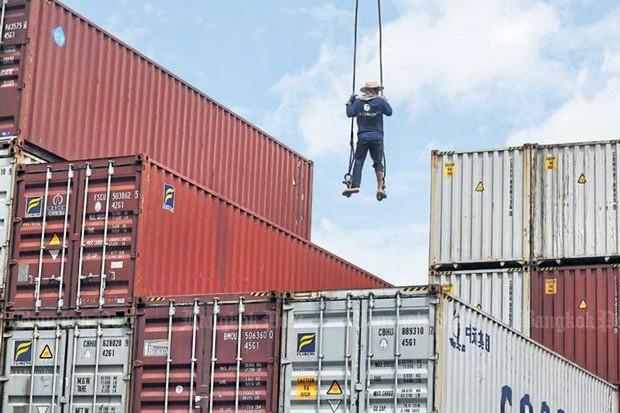Thailand: Exporters dubious of 5% target
The stronger baht may tame the pace of the export recovery and make Deputy Prime Minister Somkid Jatusripitak’s 5% growth target hard to achieve, shippers say.
“Mr Somkid has an ambitious hope of 5% growth, but in reality we might see only a 1.5-2% expansion this year,” said Nopporn Thepsithar, president of the Thai National Shippers’ Council (TNSC).
He said the slow expansion of exports and stronger baht are mainly driven by the unpredictable policies of US President Donald Trump.
The president’s policies previously led to the rate hike by the US Federal Reserve two weeks ago, Mr Nopporn said, adding that markets around the world expect a further three rate increases this year and believe that Mr Trump’s policies will help the US economy grow strongly.
If the Fed keeps raising rates, funds may flow out of emerging markets to chase higher yields in the US. Even so, recent times have seen persistent offshore fund inflows to emerging markets, including the Thai bond market.
The circumstances have pushed the Thai baht 4.7% higher against the US dollar since the beginning of 2017, making it the strongest performer among Asean currencies.
“That has become a hindrance for Thai exports,” Mr Nopporn said. “We actually hope for a brighter future, but these external factors are really unexpected. It is not only the US policy factor, but we also expect to see an impact from Brexit, which has started to proceed and slow the recovery of the world economy.”
He said that if world trade sentiment and the global economy can continually improve without the unexpected negative occurrences that could affect large economies such as the US, Japan, China and the EU, then crude and commodities prices will increase and result in growth of 2-3% for Thai exports.
That assumption is based on an exchange rate of 35-36 baht to the US dollar.
“If the Thai baht gains further to 34.50 baht a dollar, the country’s exports will make our best level at only 1.5-2% growth this year,” Mr Nopporn said.
He said crucial risk factors apart from the strong baht include US oil production policies, which are weighted towards producing more oil to use domestically and cutting oil imports.
Such policies could result in a plunge in world crude prices or stagnation at a low level, dragging down prices of other commodities and farm products.
The value of Thai exports fell for the first time in four months in February, by 2% year-on-year to UScopy8.5 billion, on weakening gold and aircraft-related exports.
TNSC vice-president Vallop Vitanakorn said March export growth is expected in a range of zero to a contraction of 2%, stemming from the appreciation of the baht against major currencies. To make matters worse, global gold prices have been steady through the first quarter and look to remain stagnant in the second, thus discouraging exporters from gold shipment and lowering export value.
Mr Vallop said first-quarter exports are likely to show growth of 1%.
Despite all the negative factors, Mr Vallop said the export sector has a chance of improvement if the country can speed up foreign direct investment in line with targets, given that high imports of machinery and capital goods indicate improving consumption in the manufacturing sector.
Import value in the first two months rose by 12.4% to $33.1 billion. Exports of agricultural products such as rice, rubber and tapioca are also climbing on the strength of proactive government policies and an international strategy to promote Thailand as a trading nation.
Mr Vallop voiced optimism that export growth could reach 3-4%, in line with the Commerce Ministry’s export target of 3-3.5%.
“However, the challenging export target of 5% set by Mr Somkid is highly unlikely to be met, given so many risk factors,” Mr Vallop said.
Some industries and agricultural exporters recently discussed the possibility of export growth in rice of 2%, in rubber of 8%, in tapioca of 3% and in sugar of as much as 20%, with overall food exports rising by 8%. Shippers see export growth of 3% in electronics, 5% in automotive and parts, 2% in textiles and 3% in electrical appliances.
Source: http://www.bangkokpost.com/business/news/1224188/exporters-dubious-of-5-target


 Thailand
Thailand




